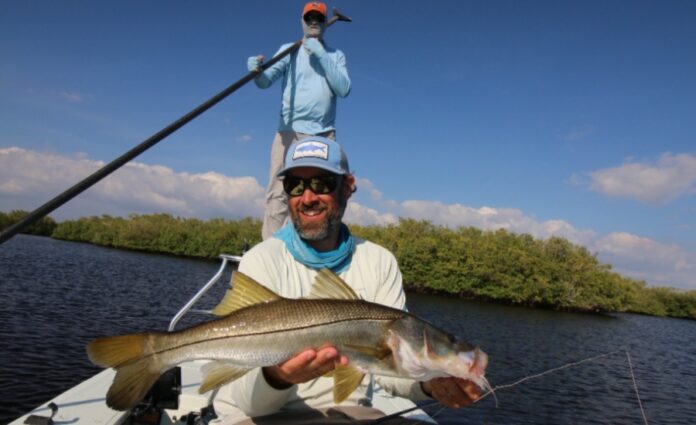All photos by Evan Jones
Mangroves are such a common sight along most tropical saltwater shorelines that anglers rarely pay much attention to them, at least until it’s time to find a shady spot for lunch. But these unique trees can contain many clues about when and where to look for gamefish, and deserve a closer look. Observant anglers can use these clues to increase their catch rates and to help identify prime fishing areas. Here are three things I’m always watching for in the mangroves:
1. The High Tide Line
Mangrove roots have evolved to withstand the saltwater, but the same is not true of their leaves. When submerged for more than a couple hours per day, they wilt and drop off, leaving a distinct line right at the average high tide mark. By comparing the current water level to this line, you can quickly and easily see what the tide is doing. Charts can sometimes be off by hours depending on the conditions, so it’s nice to have a real-time confirmation. If the tide is too low, fish won’t be able to access the protective mangrove roots, and if it’s too high, they’ll be so far back that you won’t be able to get a cast to them, so bide your time accordingly.

2. Red vs. Black
While there are many species of mangrove around the world, the two you are most likely to encounter while fishing are red and black. Red mangroves have the iconic prop roots that extend down to support their tangled mass of branches over the water, while black mangroves are surrounded by thin, straw-like roots that poke up above the water’s surface. The salient point for anglers is that red mangroves must be surrounded by water at all times, so they tend to grow around areas with deeper water and more consistent currents. Black mangroves, on the other hand, can survive dry for hours at a time, so they usually thrive near shallower, more stagnant areas that might only periodically have water. At the risk of over-generalizing, fish often seem to be more actively feeding near the red, and more likely to be laid-up and sunning themselves near the black.

3. Bird Poop Slicks
Birds do an excellent job of tracking and revealing the same baitfish schools that many saltwater gamefish follow and eat. Wherever you see a concentration of birds, you can bet there is available food nearby, which usually means the predatory fish aren’t far off. And while it’s admittedly kind of gross, one of the most surefire signs of bird activity–other than birds themselves–is the poop they leave behind on the mangrove branches where they perch. If you see significant signs of bird poop, take a few casts in the general area, and try to figure out what’s so special about that particular spot. You’ll often notice features such as pinch points funneling tidal flows, or shallow oyster bars just below the surface, which concentrate food into convenient ambush points.

Evan Jones is the assistant editor of the Orvis Fly Fishing blog. He spent a decade living on the Florida coast and now lives in Colorado.
Credit: Source link






























